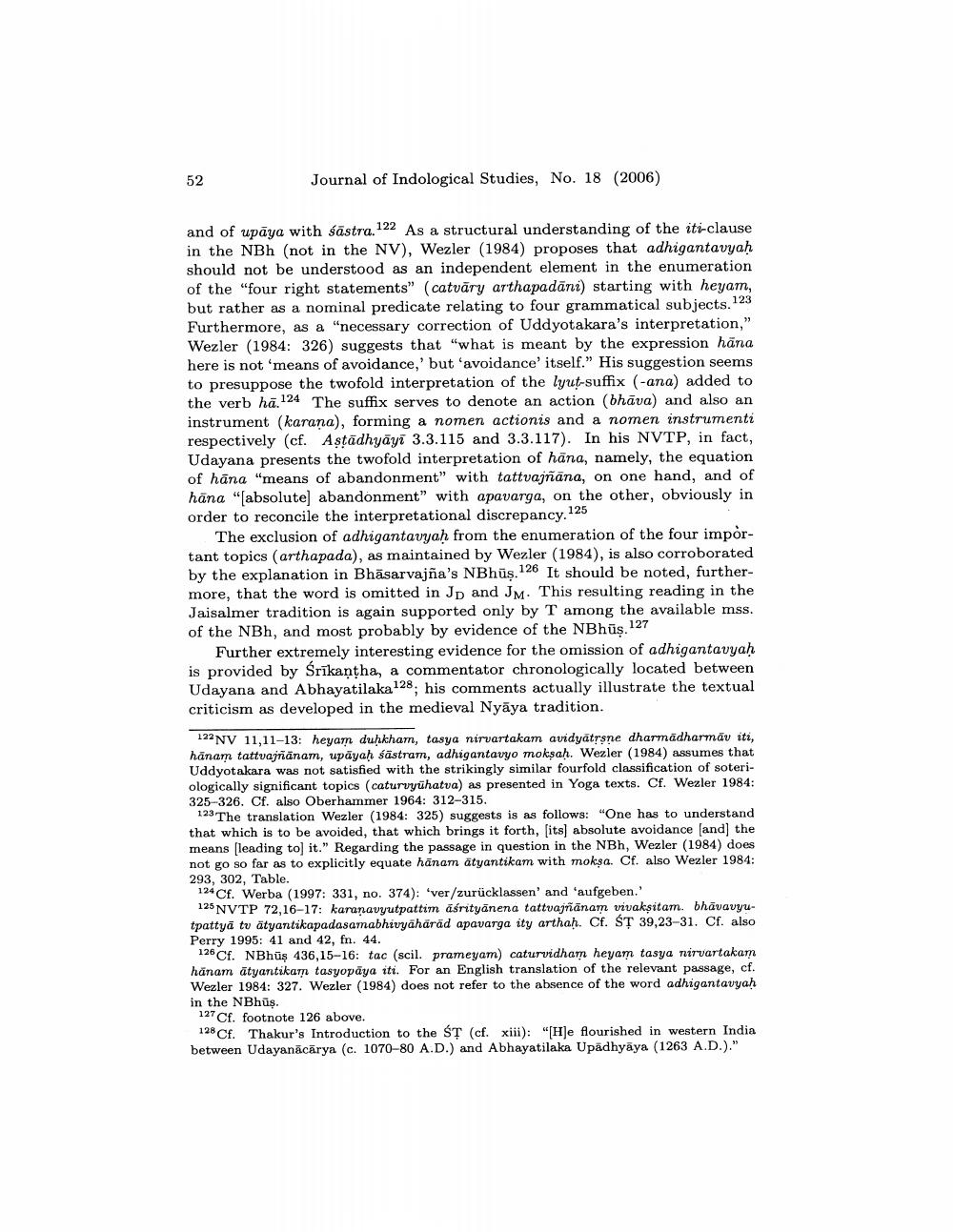________________
52
Journal of Indological Studies, No. 18 (2006)
and of upāya with śāstra 122 As a structural understanding of the iti-clause in the NBh (not in the NV), Wezler (1984) proposes that adhigantavyaḥ should not be understood as an independent element in the enumeration of the "four right statements" (catvāry arthapadāni) starting with heyam, but rather as a nominal predicate relating to four grammatical subjects. 123 Furthermore, as a "necessary correction of Uddyotakara's interpretation," Wezler (1984: 326) suggests that "what is meant by the expression hāna here is not 'means of avoidance,' but 'avoidance' itself." His suggestion seems to presuppose the twofold interpretation of the lyut-suffix (-ana) added to the verb hā.124 The suffix serves to denote an action (bhāva) and also an instrument (karana), forming a nomen actionis and a nomen instrumenti respectively (cf. Astädhyāyi 3.3.115 and 3.3.117). In his NVTP, in fact, Udayana presents the twofold interpretation of hāna, namely, the equation of hāna "means of abandonment" with tattvajñana, on one hand, and of hāna "absolute) abandonment” with apavarga, on the other, obviously in order to reconcile the interpretational discrepancy. 125
The exclusion of adhigantavyaḥ from the enumeration of the four important topics (arthapada), as maintained by Wezler (1984), is also corroborated by the explanation in Bhāsarvajña's NBhūş. 126 It should be noted, furthermore, that the word is omitted in Jp and JM. This resulting reading in the Jaisalmer tradition is again supported only by T among the available mss. of the NBh, and most probably by evidence of the NBhüş.127
Further extremely interesting evidence for the omission of adhigantauyah is provided by Śrīkantha, a commentator chronologically located between Udayana and Abhayatilaka 128; his comments actually illustrate the textual criticism as developed in the medieval Nyāya tradition.
122 NV 11,11-13: heyam duḥkham, tasya nirvartakam avidyātrsne dharmadharmāv iti, hānam tattvajñānam, upāyaḥ śästram, adhigantavyo mokşah. Wezler (1984) assumes that Uddyot akara was not satisfied with the strikingly similar fourfold classification of soteriologically significant topics (caturvyuhatva) as presented in Yoga texts. Cf. Wezler 1984: 325-326. Cf. also Oberhammer 1964: 312-315.
123 The translation Wezler (1984: 325) suggests is as follows: "One has to understand that which is to be avoided, that which brings it forth, [its) absolute avoidance and the means [leading to it." Regarding the passage in question in the NBh, Wezler (1984) does not go so far as to explicitly equate hānam atyantikam with mokşa. Cf. also Wezler 1984: 293, 302, Table. 124 Cf. Werba (1997: 331, no. 374): 'ver/zurücklassen' and 'aufgeben.' 128 NVTP 72,16-17: karanavyutpattim aśrityānena tattvajñanam vivaksitam. bhāvavyutpattyā tu ätyantikapadasamabhivyähärad apavarga ity arthah. Cf. ST 39,23-31. Cf. also Perry 1995: 41 and 42, n. 44.
128 Cf. NBhūş 436,15-16: tac (scil. prameyam) caturvidham heyam tasya nirvartakam hānam atyantikam tasyopaya iti. For an English translation of the relevant passage, cf. Wezler 1984: 327. Wezler (1984) does not refer to the absence of the word adhigantavyah in the NBhūş. 127 Cf. footnote 126 above.
128 Cf. Thakur's Introduction to the ST (cf. xiii): "Hje flourished in western India between Udayanacärya (c. 1070-80 A.D.) and Abhayatilaka Upadhyāya (1263 A.D.)."




